Research
Stalk Lodging
Maize is a multi-billion-dollar industry world-wide that contributes to many goods throughout the world. The stalks of these plants occasionally fall over due to a failure called stalk lodging. When this occurs, the plant dies and the corn is not harvestable. This results in major losses around the globe. This problem has only recently been approached from an engineering perspective. Our lab analyzes and tests corn stalks to understand the characteristics that resist failure. This knowledge can equip breeders in industry with knowledge to mitigate this issue.

Devices
Portable measurement devices can be sent to any location and used on a farm to identify the characteristics of the current crop. We develop devices that will be useful for measuring strength and shape of crops on-site. We have a device that measures the strength of stalks to resisting lodging and a device that can slice a live specimen and take detailed photographs of the cross-section.

Geometric Parameterization
Understanding geometric features found in corn stalks is vital to resisting lodging. Our lab is seeking to fully parameterize a corn stalk into a simpler model that accurately represents the performance of live stalks. A sufficient 2D model has been generated and validated already. The 2D model uses an elliptical approximation and principal component analysis to create an accurate parameterization. Further parameterizing the stalk in 3D is in progress.

Stalk Profile
Much of the research performed in the lab hinges on understanding the geometry of stalk plants. Using the elliptical parameterization of the cross-section as a guide, the following animation demonstrates how this profile changes as we travel along a stalk.
Leaf Sheaths
The anatomy of stalk plants includes a sheath layer. This layer stretched the length of a node before emerging as a leaf. This layer is believed to serve a critical structural role during plant adolescence. The key to solving the stalk lodging problem may lie with the sheath that supports a stalk in younger stages of life. We analyze the effect of the leaf sheath in stalk strength throughout the span of a plant’s lifetime. Our lab conducts lab testing using precision instruments as well as on-site testing using lab-developed devices.

Computational Modeling
Corn stalks were put through computerized tomography (CT) scans to generate geometric data. Using computational methods, our lab analyzes structural responses of stalk geometry under various loading conditions. The information found in these studies are useful in validating parameterization and for determining parameter importance in a model. The computational modeling techniques used in the Crop Biomechanics Lab are an efficient way to test a large number of samples in an inexpensive manor.

Mechanical Tissue Property Measurements
Mechanical properties of plants are imperative for accurate modelling, but also difficult to measure. Little work has been done to find sufficient measurements of these properties in stalk plants. We use thousands of samples that come from our self-grown corn in this research. Using various high-precision instruments, our lab is honing in on accurate measures of these mechanical tissue properties.
